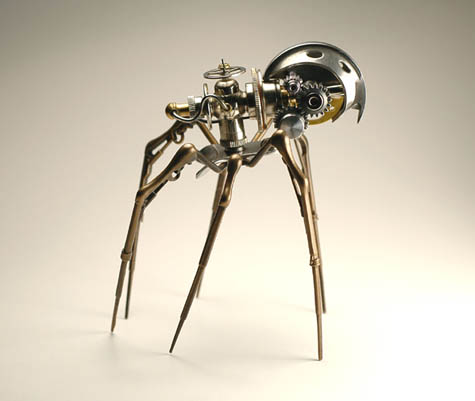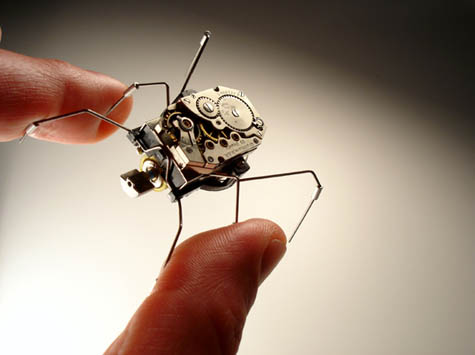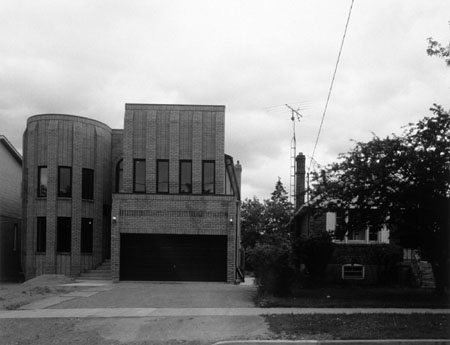Conspiracy Dwellings
"The next time a moth alights on your window sill," New Scientist warns, "watch what you say. Sure, it may look like an innocent visitor, irresistibly drawn to the light in your room, but it could actually be a spy – one of a new generation of cyborg insects with implants wired into their nerves to allow remote control of their movement."
 [Image: A Steam Insect by sculptor Christopher Conte; photo by Amanda Dutton/Synesthesia Photo].
[Image: A Steam Insect by sculptor Christopher Conte; photo by Amanda Dutton/Synesthesia Photo].
What fascinates me about that statement, much more than simply pointing out how advanced surveillance technology has become, is the fact that such thoughts would have been dismissed as absolute schizophrenia as little as two decades ago.
Pointing out the window at insects as you whisper: They're listening...
 [Image: A Battery Powered Microbotic Insect by sculptor Christopher Conte].
[Image: A Battery Powered Microbotic Insect by sculptor Christopher Conte].
Which leads me to wonder if, all along, "human history" has really just been the production, in physical form, of someone else's mental state – our world is their dream, then, and it is their ideas within which we live. Inventors, industrialists, entrepreneurs, emperors, kings, architects, artists.
In any case, I'm also curious if these sorts of paranoias are ever directed at landscapes and the built environment. In Stasi-era East Germany, for instance, was there ever a kind of architectural paranoia, when you realized that your neighbor's house was not, in fact, a house... but a listening post for the government.
In fact, I'm reminded of an old post on BLDGBLOG in which we saw photographs by Robin Collyer documenting houses that aren't houses at all: they're disguised electrical substations built to look like detached single-family bungalows.
 [Image: 555 Spadina by Robin Collyer; this is not a house but an electrical substation].
[Image: 555 Spadina by Robin Collyer; this is not a house but an electrical substation].
Will there ever be articles in New Scientist saying: "The next time you use a doorknob, it may not be a doorknob at all..."
Or: "The next time you stay in a hotel room, it may not be a hotel room at all, but a top secret government research lab..."
Is there an architectural paranoia? And, if so, what would the treatment be – walking tours of all the unmarked buildings downtown? Nights spent alone with your psychoanalyst in empty suburban houses?
How does one treat an architectural affliction?
 [Image: 96-98 Olive Ave., North York by Robin Collyer – another disguised electrical substations].
[Image: 96-98 Olive Ave., North York by Robin Collyer – another disguised electrical substations].
And what about landscape? You drive past a "cornfield" – but you know it's not a cornfield. "This is not a cornfield," you whisper. "I think it's listening to us." The stalks look funny, and they don't sway with the wind. You and your friends go camping in the forests of northern California, but you sit there outside your tent all night, eyeing the redwoods. "These aren't trees," you insist every few minutes. "I don't think these are trees."
So can landscapes and the built environment sustain paranoid projections? If we can imagine, as per the New Scientist article cited above, that a moth at the window is really a government surveillance device, then surely we can imagine that whole buildings and fields not be what they seem?
 [Image: Screen shots from artist Pam Skelton's recent project Conspiracy Dwellings, about the apartments and rooms used by the Stasi to spy on East Germany].
[Image: Screen shots from artist Pam Skelton's recent project Conspiracy Dwellings, about the apartments and rooms used by the Stasi to spy on East Germany].
This makes me think of Judge Schreber, the famously schizoid target of one of Sigmund Freud's later analyses, who, upon being institutionalized, made sure to diagram the spatial layout of the hospital for fear that the rooms and layouts might change or betray him. His legendarily bizarre autobiography thus includes hospital floorplans. Was the architecture itself part of some vast conspiracy? his illness seemed to ask.
One need only turn to someone as obvious as Franz Kafka to see that architecture has a capacity to frustrate and enrage that few other art forms ever manage.
Finally, then, in a recent issue of Abitare I came across a project by artist Pam Skelton called Conspiracy Dwellings:
In any case, this all takes us back to the ever-watchful robot insects of the future, with which this post started – and so we could perhaps rephrase that opening statement from New Scientist like this: "The next time you walk into a building, watch what you say. Sure, it may look like an innocent piece of architecture, but it could actually be a spy – one of a new generation of cyborg buildings with implants wired into its walls to allow remote control of the built environment." Or some other such formulation.
But the fundamental question remains: how is architecture reimagined, or refigured, when it becomes the target of paranoia?
 [Image: A Steam Insect by sculptor Christopher Conte; photo by Amanda Dutton/Synesthesia Photo].
[Image: A Steam Insect by sculptor Christopher Conte; photo by Amanda Dutton/Synesthesia Photo].What fascinates me about that statement, much more than simply pointing out how advanced surveillance technology has become, is the fact that such thoughts would have been dismissed as absolute schizophrenia as little as two decades ago.
Pointing out the window at insects as you whisper: They're listening...
 [Image: A Battery Powered Microbotic Insect by sculptor Christopher Conte].
[Image: A Battery Powered Microbotic Insect by sculptor Christopher Conte].Which leads me to wonder if, all along, "human history" has really just been the production, in physical form, of someone else's mental state – our world is their dream, then, and it is their ideas within which we live. Inventors, industrialists, entrepreneurs, emperors, kings, architects, artists.
In any case, I'm also curious if these sorts of paranoias are ever directed at landscapes and the built environment. In Stasi-era East Germany, for instance, was there ever a kind of architectural paranoia, when you realized that your neighbor's house was not, in fact, a house... but a listening post for the government.
In fact, I'm reminded of an old post on BLDGBLOG in which we saw photographs by Robin Collyer documenting houses that aren't houses at all: they're disguised electrical substations built to look like detached single-family bungalows.
 [Image: 555 Spadina by Robin Collyer; this is not a house but an electrical substation].
[Image: 555 Spadina by Robin Collyer; this is not a house but an electrical substation].Will there ever be articles in New Scientist saying: "The next time you use a doorknob, it may not be a doorknob at all..."
Or: "The next time you stay in a hotel room, it may not be a hotel room at all, but a top secret government research lab..."
Is there an architectural paranoia? And, if so, what would the treatment be – walking tours of all the unmarked buildings downtown? Nights spent alone with your psychoanalyst in empty suburban houses?
How does one treat an architectural affliction?
 [Image: 96-98 Olive Ave., North York by Robin Collyer – another disguised electrical substations].
[Image: 96-98 Olive Ave., North York by Robin Collyer – another disguised electrical substations].And what about landscape? You drive past a "cornfield" – but you know it's not a cornfield. "This is not a cornfield," you whisper. "I think it's listening to us." The stalks look funny, and they don't sway with the wind. You and your friends go camping in the forests of northern California, but you sit there outside your tent all night, eyeing the redwoods. "These aren't trees," you insist every few minutes. "I don't think these are trees."
So can landscapes and the built environment sustain paranoid projections? If we can imagine, as per the New Scientist article cited above, that a moth at the window is really a government surveillance device, then surely we can imagine that whole buildings and fields not be what they seem?
 [Image: Screen shots from artist Pam Skelton's recent project Conspiracy Dwellings, about the apartments and rooms used by the Stasi to spy on East Germany].
[Image: Screen shots from artist Pam Skelton's recent project Conspiracy Dwellings, about the apartments and rooms used by the Stasi to spy on East Germany].This makes me think of Judge Schreber, the famously schizoid target of one of Sigmund Freud's later analyses, who, upon being institutionalized, made sure to diagram the spatial layout of the hospital for fear that the rooms and layouts might change or betray him. His legendarily bizarre autobiography thus includes hospital floorplans. Was the architecture itself part of some vast conspiracy? his illness seemed to ask.
One need only turn to someone as obvious as Franz Kafka to see that architecture has a capacity to frustrate and enrage that few other art forms ever manage.
Finally, then, in a recent issue of Abitare I came across a project by artist Pam Skelton called Conspiracy Dwellings:
- Conspiracy Dwellings is a visual arts project that explores the legacy of state surveillance. Presented are a network of almost 500 secret apartments and institutions in Erfurt from which the former East German Ministry of State Security (Stasi) operated from 1980 to 1989. Initiated by British artist Pam Skelton and German scholar Joachim Heinrich, the project displayed audio/video installations in locations around the city of Erfurt based on the network of conspiracy dwellings that were used for spying and denunciation, and [it] uses the original locations of the conspiracy dwellings to reveal the surveillance practices of that time. Set up to maintain secrecy in an environment of fear, observation and control, the "home" proved to be an effective tool for spying on friends, colleagues and family.
In any case, this all takes us back to the ever-watchful robot insects of the future, with which this post started – and so we could perhaps rephrase that opening statement from New Scientist like this: "The next time you walk into a building, watch what you say. Sure, it may look like an innocent piece of architecture, but it could actually be a spy – one of a new generation of cyborg buildings with implants wired into its walls to allow remote control of the built environment." Or some other such formulation.
But the fundamental question remains: how is architecture reimagined, or refigured, when it becomes the target of paranoia?





Comments are moderated.
If it's not spam, it will appear here shortly!
Do we move to the suburbs to insulate ourselves from surveillance or are the suburbs provided to isolate us into conveniently observable units. I find some comfort in the thought that the more ubiquitous surveillance becomes the more we recover our anonymity, although I'm sure Google or someone is busy developing more efficient means of sorting through the increasing mounds of information.
What a fantastic post.
I blogged about this entry on my own site, Fatedplace.blogspot.com
I wonder about the cascade effect: What happens when we increasingly mechanize our own products into representations of themselves. At some point will we simple make models of models?
...how is architecture reimagined, or refigured, when it becomes the target of paranoia?
That all depends upon who the paranoiac is, and whom they regard as a target of their observations.
For example, have the thousands of London's cameras transformed it into a City of the Watched, or a City of the Watchers? Which end of the camera is the paranoia on?
Here's lookin' at ya, Bro. Where is a Hobbit (or a fly swatter) when you need one?
Iain Sinclair is great on the superabundance of surveillance cameras:
The new city has exploited images of terror, wrecked buildings, newsreel carnage routines, as an explanation of its desire to seal itself off, to put up physical barriers at all ports of its entrance. Vague spectres of menace caught on time coded surveillance cameras justify an entire network of peeping vulture lenses, A web of indifferent watching devices, sweeping every street, every building, to eliminate the possibility of a past tense, the freedom to forget. There can be no highlights, no special moments: a discreet tyranny of now has been established. “Real time” in its most pedantic form. It is only when there is no one to watch the watchers, when the machines are left to hose imagery on to banked screens in an empty room, that a melancholy futuristic poetic begins to operate: visionary street scenes unrivalled since the birth of cinema. The delight of a thing that is simple itself, mechanical process in all its essential mystery; a train coming into a station, firefly lights from a river of slow moving cars. A cinema that spurns the vulgar excitement of editing, the control freak buzz of nominating the close-ups, moving the camera. The inner sanctum of surveillance imagery in Bishopsgate Police Station oversees this revolutionary movement, this new art from: the City is at last able to compose its own poetry, with no human intervention...
In a couple of decades the privacy will probably be a thing of the past. Moth cameras are only the first step, a crude technology that will be refined further with development of nanobots. Imagine billions of invisible surveillance machines no bigger than a bacteria. There's no way to escape their eyes. The all knowing, ever watching and eternal... The
man will indeed construct himself a God but it will not be One, it will be Many...
What would a building look like that was based on the concept of the opposite of paranoia, pronoia?
John Perry Barlow defined the word as meaning the suspicion the Universe is a conspiracy on your behalf.
We always knew that a door was not a door when it was ajar...
as surveillance technology advances, so does the prevention of it. I'm wondering if most surveillance tech could be shorted out by or stopped by something...
Post a Comment